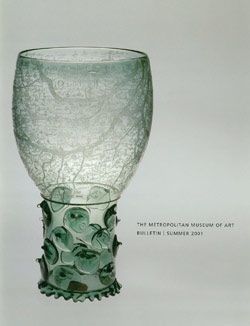Floral plaque
Ptolemaic Period–Roman Period
Glass plaques were employed in the Hellenistic and Roman Mediterranean world to decorate walls, screens, and furnishings. This particular fresh and exuberant floral type was popular chiefly in Egypt and was probably manufactured in Middle Egypt.
Panels of this sort, which are thought to have originally been up to six inches tall and just under three inches wide, exhibit a characteristic set of vegetal motifs. While correlations to actual species are difficult to make, three nelumbo lotus flowers can be identified at the bottom of this plaque, and what appear to be two grape clusters are recognizable at either side of the fanlike group of leaves in the center.
The plaque was made by fusing cross sections of mosaic canes, colored strips, and chips of bluish green glass, with an added backing of chips and waste glass for thickening. The front was then ground and polished to smoothness. The slight translucency of the matrix glass is an effect of backlighting and would not have been apparent when the panel was set in place
Due to rights restrictions, this image cannot be enlarged, viewed at full screen, or downloaded.
This artwork is meant to be viewed from right to left. Scroll left to view more.




